City parks offer fun encounters with Chuseok traditions
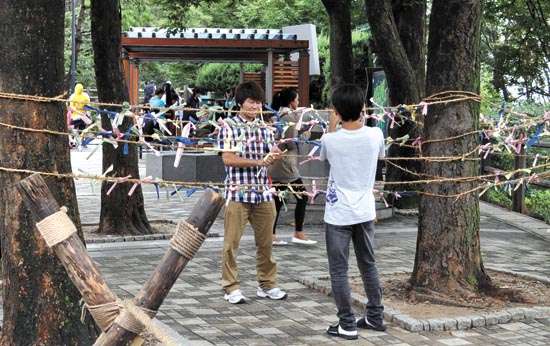
Visitors hang pieces of paper containing their wishes at World Cup Stadium Park. Provided by the Seoul Metropolitan Government
This weekend, Koreans celebrate Chuseok. The nation’s harvest holiday is a time for Koreans to gather with relatives to share food and give thanks to their ancestors. This year, Chuseok is officially on Monday according to the Lunar calendar, but the holiday is observed for three days from Sept. 11 to 13.
Since many Koreans will hit the road during this time to visit relatives outside of Seoul, the capital will be relatively free of crowds, providing those choosing to remain in the city with a perfect opportunity to unwind.
People will also have a chance to experience traditional Chuseok games and customs through a series of 27 Chuseok-related activities in 16 parks, as announced last week by the Seoul Metropolitan Government.
Just as each park in Seoul has its own characteristics and history, the programs offered at each park will be slightly different as well.
“We have prepared several Chuseok programs at city parks for Seoulites to enjoy,” Choi Kwang-bin, the head of the Seoul Metropolitan Government’s Green Seoul Bureau, said. “The parks will have a lot to offer those who don’t visit their hometown or spend the holiday in Seoul.”
So, if sitting on a couch and watching movies is your only plan during this year’s Chuseok holiday, you might want to consider going out to a park with family or friends instead.
In that spirit, the Korea JoongAng Daily has chosen six parks among the 16 offering holiday programs that just might tempt you out of your house this holiday season.
Dream Forest
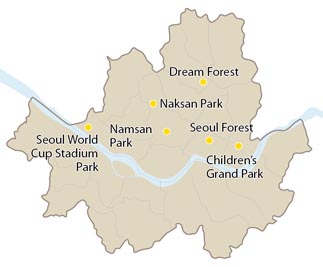
The park was originally the location of Seoul’s first theme park, Dream Land but financial problems kept the park from succeeding and the Seoul city government announced in 2007 that it would turn it into a green space. Dream Forest was finally unveiled in 2009.
The park offers natural attractions such as Wolyeongji (Moon Reflecting Pond) and Wolgwang Falls (Moonlight Falls), which were designed in the traditional style. There is also a 49.7-meter observatory that offers a view of Bukhan, Dobong and Surak mountains. Dream Forest also has many cultural venues, including Dream Forest Arts Center, Concert Hall and Dream Forest Museum of Art.
On Monday, there are folk games at Changnyeongwigung Ancestral Shrine (Registered Cultural Heritage No. 40) and Cultural Plaza from 2 p.m. to 5:30 p.m. There will also be a concert by a group that plays minyo (folksong) at 5 p.m. at the Dream Forest Arts Center’s outdoor stage.
For more information, call (02) 2289-4001 or visit dreamforest.seoul.go.kr.
Address: Beon-dong 28-6, Gangbuk District
Subway Line 1: Wolgye Station, exit 2, and walk 50 meters or Seogye Station, exit 7, and walk 20 meters
Subway Line 4: Mia Samgeori Station, exit 1, and walk 10 meters
Subway Line 6: Dolgoji Station, exit 3, and walk 30 meters
Subway Line 7: Hagye Station, exit 5, and walk 100 meters
Seoul World Cup Stadium Park
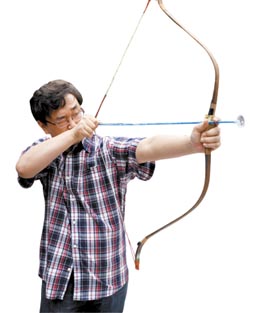
The park is made up of five small parks including Peace Park, Haneul Park, Noeul Park, Nanjicheon Park and Nanji Hangang Park.
An interesting event will be held at Jangseung Plaza in Peace Park during the Chuseok holiday. There will be traditional folk games and a traditional ritual called “dalbit sowon bilgi” (moonlight wishes). As part of the ritual, visitors write their wishes on a piece of paper and hang the paper on a rope, in hopes that their wishes come true.
The origin of the ritual can be traced back to ancient religious practices that centered around the significance of the moon. In ancient times, the sun’s presence was considered routine, but the full moon that came once a month, brightening the night sky, was considered a special and meaningful event. Therefore, people performed the ritual with the hope that they would reap energy and good luck from the power of the moon.
For more information, call (02) 300-5000~2 or visit worldcuppark.seoul.go.kr.
Address: Seongsan-dong, Nanjidogil 45-1, Mapo District
Subway directions: World Cup Stadium Station, line No. 6, exit 1 or 2
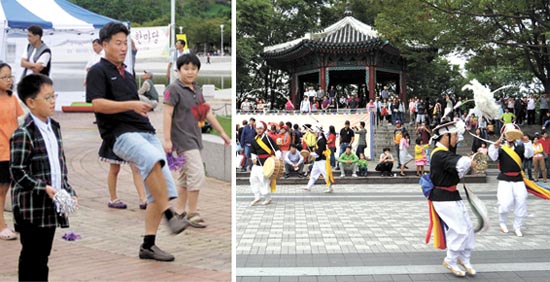
Left: Kids play jegi-chagi (Korean Hacky Sack). Right: Members of a farmer’s band dance at Namsan Park.
Namsan Park
Located in the center of Seoul, Mount Namsan has long been a landmark for Seoul residents.
In addition to the range of activities at Namsangol Hanok Village, this year there will be numerous cultural programs at Palgakjung (Octagonal Pavilion).
On Monday at 2 p.m., there will be a tteok (rice cake) making workshop where visitors can try their hand at this traditional Chuseok activity. Two hours later at 4 p.m. there will be a ssireum (Korean wrestling) competition that is open to anyone. The traditional sport is a one-on-one match in which two competitors face each other in the middle of a sand pit. The last wrestler left standing after a series of competitions is considered the winner. In the early evening, performers will play gukak (traditional music) and teach workshops in traditional music instruments like gayageum (12-stringed zither).
On Tuesday, visitors can learn to make tal (masks).
There will be traditional games offered on both days, including neol-ttwigi (seesaw jumping), tuho (arrow toss), jegi-chagi (Korean Hacky Sack), and paengi-chigi (top spinning).
For more information, call (02) 3783-5900.
Address: Hoehyeon-dong 1-ga, Jung District
Subway directions: Myeongdong Station, line No. 4, exit 3, and walk for 10 minutes in the direction of Lila Elementary School
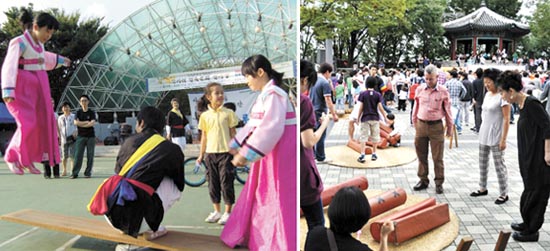
Left: A woman jumps during a game of neol-ttwigi (seesaw jumping) at Seoul Forest. Right: Visitors play a large version of the traditional game yutnori at Namsan Park.
Naksan Park
Located near Daehangno, the city’s theater district and a popular place with young people, Naksan Park gets its name from its appearance. In Korean, “nakta” means “camel” and “san” means “mountain.” During the Japanese colonial period, hasty urban planning resulted in the demolition of most of the mountain, leaving it looking like a camel’s hump. Later, in an effort to save the remaining green belts, Naksan was designated a park on June 10, 2002.
The highlight of Naksan’s Chuseok program is a performance and music lessons by gukak (Korean music) group Horanga Nolja. Visitors will learn how to play traditional instruments such as the gayageum (12-stringed zither) and haeguem (fiddle). The performance will be at 5 p.m. on Tuesday. For more information, call (02) 743-7985.
Address: Dongsung-dong 2-10, Jongno District
Subway directions: Go to Hyehwa Station, line No. 4, exit 2, and walk for 10 minutes toward Maronnier Park and IBK.
Seoul Forest
In the past, kings used Seoul Forest as a royal hunting ground. But in recent years, the area has opened to the public with a variety of attractions. Consisting of five parks - Cultural Art Park, Ecological Forest, Nature Experiencing Study Field, Wetlands Ecological Field and Han River Waterside Park - it spreads over 1,156,498 square meters (286 acres).
Originally, the city tried to turn the area into a residential zone, but it was later opened as a park on June 18, 2005.
It has a golf course, a horse racing track and lots of sports facilities. There is also an insect botanical garden with 2,233 trees of 200 species, 297 insects of 106 species, and 12,472 plants of 81 species.
Starting on Monday at 1 p.m., kids who wear hanbok (traditional Korean costume) will be given a beetle larvae and offered the opportunity to learn how to raise it. The event is first come first served at Butterfly Garden and only 100 beetle larvae will be given out.
During the Chuseok holiday, Seoul Forest will also organize folk games including yutnori, a traditional board game using four wooden sticks.
For more information, call (02) 460-2901.
Address: Seongsu 1-ga dong 685, Seongdong District
Subway directions: Get off at Ttukseom station (line No.2) and then get out from exit 8, take 10 minutes walk from there
Children’s Grand Park
Children’s Grand Park has been a great leisure place for families since it opened in 1973 on Children’s Day, May 5. The park has loads of attractions, including a zoo, botanical garden, amusement facilities, outdoor stages and sports facilities.
A samulnori percussion quartet will play from 3 to 5 p.m. on Monday and there will also be a gilnori parade, during which musicians wish the audience good luck.
There will also be folk games from 10 a.m. to 5 p.m. Saturday to Tuesday, including neol-ttwigi (seesaw jumping), tuho (arrow toss), jegi-chagi (Korean Hacky Sack), and paengi-chigi (top spinning).
If you miss the performance, there will be another on Sept. 18 with folk group Gyeongseodo Changakhoi. The group will play traditional music such as gayageum and pansori (narrative singing) and present a fan dance and gut (shamanic ritual).
For more information, call (02) 450-9311 or visit www.childrenpark.or.kr.
Address: Neung-dong 18, Gwangjin District
Subway directions: Children’s Park Station, line No. 7, exit 1
By Joo Kyung-don [kjoo@joongang.co.kr]
한글 관련 기사 [중앙일보]
서울광장·민속촌 등 한가위 축제
추석에 고향에 가지 못하는 사람은 수도권에서 명절 분위기를 한껏 즐겨보자. 주말과 겹친 연휴 동안 서울.경기 곳곳에서 전통놀이와 각종 공연이 어우러진 풍성한 한가위 축제가 이어진다.
◆ 서울광장= 추석인 18일부터 이틀 동안 국악 공연을 감상하며 전통놀이를 직접 해볼 수 있다. 광주시립 국극단과 영산예술단 등이 출연, 사물놀이와 판소리 등을 들려준다. 18일 공연에선 신영희씨가 '춘향가'의 한 대목과 '진도 아리랑' 등을 부른다.
19일 공연은 춘향가 완창 최연소 기록을 가진 이자람씨가 사회를 맡아 국악을 젊은 시각으로 풀이한다. 이틀간 오후 4~9시에 열리는 공연은 시민과 출연진이 함께하는 강강술래로 막을 내린다.
서울광장 전통놀이 체험행사 중 대형 윷놀이, 대형 팽이치기 등은 아이들과 어른이 함께 즐길 만 하다. 전통놀이체험은 18.19일 오후 2시에 시작한다(02-3472-2377).
◆ 남산골 한옥마을= 한옥마을 천우각 광장, 박영효 가옥 등에서는 17일부터 사흘간 공연.전시.체험 마당이 열린다. 서커스.탈춤 공연, 송편빚기 체험 등 20여개의 행사가 준비돼 있다. 각 행사별 일정은 홈페이지(www.hanokmaeul.org)에서 확인할 수 있다(02-2266-6923).
◆ 역사박물관=18일 저녁 6시부터 보름달 아래에서 강강술래를 해볼 수 있다. 참가자 모두가 한데 어우러져 강강술래.대동놀이를 펼친다. 대동놀이에 쓰일 깃발도 직접 만들어 보게 된다. 대북 등을 두드리는 타악공연도 감상할 수 있다(02-724-0193).
◆ 각 자치구와 공원= 마포구.은평구.강서구.금천구.서초구.송파구.동대문구.종로구.양천구 등 자치구에서도 놀이마당, 국악 공연을 준비했다.
서초구는 이은관 명창을 초청해 '팔도강산 소리여행' 공연을, 은평구는 연신내 물빛 공원에서 '추석맞이 가을음악회'를 연다.
서울 곳곳의 공원들도 다양한 추석맞이 행사를 선보인다. 뚝섬의 서울숲에서는 17~19일 출생.결혼.죽음 등 통과의례를 주제로 축제를 연다. 해외의 특색있는 성인식과 굿, 상여 행렬 등을 볼 수 있다. 동숭동 낙산공원에서는 16~18일 독립영화 6편을 상영하고 전통놀이를 해볼 수 있는 축제를 펼친다. 어린이공원, 보라매 시민의 숲 등에서도 '도시 속 한가위'를 맛볼 수 있다.
◆ 경기지역= 한국민속촌은 추석 당일인 18일 한가위 큰굿과 농악을 공연하고 마상무예와 널뛰기.줄타기 등 각종 묘기를 보여준다. 17~19일에는 전통추수체험행사와 함께 모닥불에 모여 앉아 군고구마와 밤.땅콩 등을 구워먹는 '추억의 먹거리 체험 한마당',직접 송편을 빚고 시루에 쪄서 맛보는 '세시풍속 체험행사' 등을 연다.(031-288-0000). 남한산성에서도 16일 오후 3시 국악 큰잔치가 열려 선소리 타령과 서도민요와 함께 풍물공연, 퓨전국악연주 등을 감상할 수 있다(031-729-4222).










with the Korea JoongAng Daily
To write comments, please log in to one of the accounts.
Standards Board Policy (0/250자)